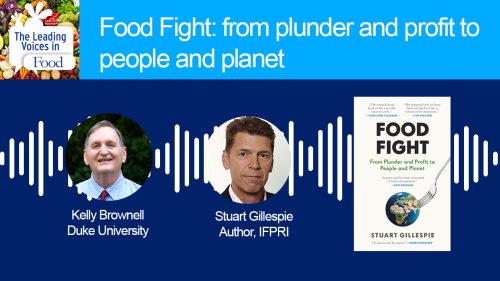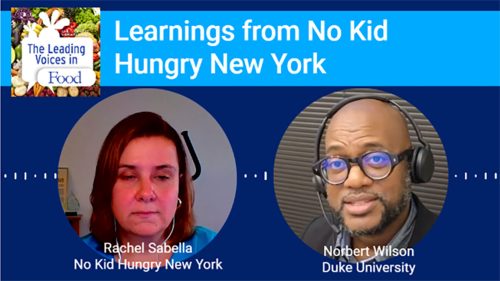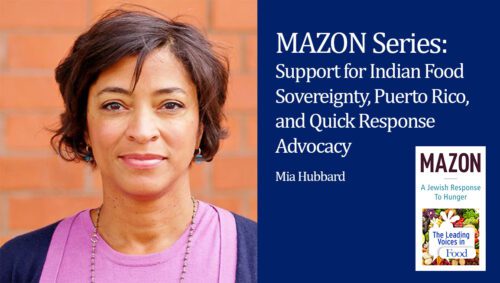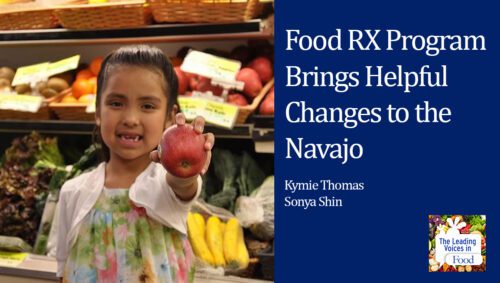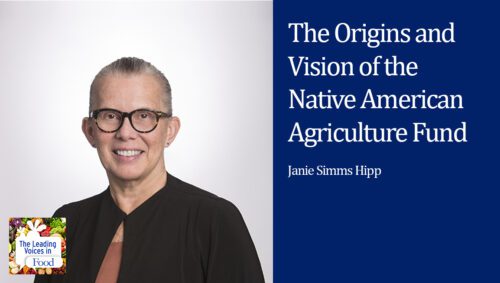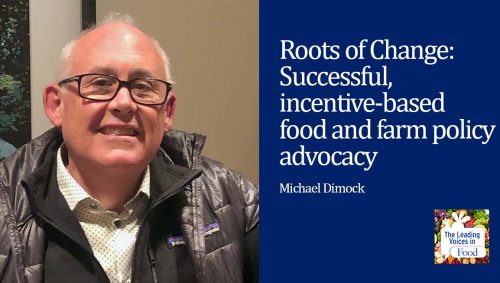The Leading Voices in Food
E82: Rediscovering Navajo Indigenous Agricultural Wisdom
There’s a great deal to learn from the deep connections between regenerative agriculture and the farming traditions of First Nations people. My guest today is James Skeet, a member of the Navajo Nation and the founder of Spirit Farm in New Mexico, a demonstration farm that draws both Native Americans and others to learn more about issues like composting and regenerative farming techniques.

James Skeet and Joyce Skeet, in partnership with Covenant Pathways, have been organizing food drives on the Navajo Reservation in New Mexico for several years. Their vision is to reintroduce farming with the Navajo Community by sharing permaculture techniques that use less water while increasing plant production. With the addition of a hoop house, the fresh produce will be available for months outside of the growing season.
Interview Summary
How would you say that farming and conservation and preservation are a part of your cultural heritage?
As I look back historically and through our traditional perspectives, who we are as a people, indigenous worldview is something that is very important to the earth and to the relationship to the environment, especially here in the Southwest. The climate, it can be harsh as well as very sustainable. A very delicate process. It’s not something that can be done quickly. You have to look at seasons rather than what you’re producing.
So, James, as people think about the term regenerative agriculture, one might conclude that it’s new on the scene? But you’re making the point that it’s not new on the scene at all, that there are hundreds of generations of people who have been working on doing just this.
Indigenous people have always had this organic mindset that all things are sacred. Nature is to be respected and copied. Time is not linear but secular. There’s always been sort of a bartering regenerative economy there, dealing with our relationship with different tribes. And then, food is considered as medicine. Because the plants were here first, they’re our grandfathers and grandmothers. So they’re teaching us things about that relationship with the environment. And it goes into some deep religious activities, ceremonies to have that relationship.
It’s really biology based. We were looking at minimal disturbance, especially when the Navajos went into a sheep economy, which was after the introduction of Churro sheep from the Spaniards. We had some of the tallest grasses in the so-called New World because they were using herding techniques that went from summer camps to winter camps. That relationship with the sheep and the biology and the soil, the grasses, to maximize productivity in the grasses.
My guess is that many people would look at the landscape where you do your farming and think that it just wouldn’t be possible to grow enough food to survive there. How would you respond to that?
I would totally agree with that. The way we’ve understood farming has been based on annual crops, monocropping, productivity, but indigenous people have looked outside of that box to where hunters and gatherers were a type of farming that was taking place with the relationship with their herding animals, as well picking plants as they go along. And what we’re trying to do is really a subtle edge, and that’s where the complexity of our religions come from. Delicate relationships with Mother Earth and Father Sky. A lot of these ruins dictate to us, now looking back, their dependency on annual crops, corn, beans, squash, a lot of indigenous people all understood the relationship between plants that were outside of that category, the annual crops. They would focus on what we call weeds today. If you study the nutrient density of those plants, their medicinal nutrient values are very high.
My mom was an herbalist. That understanding of our environment has really been misunderstood or overlooked. I really feel like what would we call food deserts, aren’t really food deserts. It’s in our minds that we think that it’s a desert, but in reality what nature, like I said before, grandfathers and grandmothers, are reaching out today and saying, I can heal you if you reestablish that relationship. And that cosmology is really another way of interpreting the goodness of Mother Nature. The idea of sustainability.
Could you tell us a bit more about Spirit Farm, and what inspired you to do this work? And, how do you do things differently than what conventional farmers might do?
Yeah, it really has to do with epistemology, how we view the world, view nature. Do we look at reductionists rather than systems? My wife and I, we were working for a managed care organization for a number of years. But in the back of our minds we felt like, why are indigenous people getting sicker? Why are they unhealthy? And the more we looked into that, we realized that it was the relationship they had with the kinds of foods. They had plenty of food, but it wasn’t the right kind of nutrient dense foods.
So, we had to really look at what can we do instead of complaining about the colonization, how we’ve been overtaken by the European Western world view, what can we do? We decided to just farm, to get back to nature, step off this corporate machinery, and we had some land there that my folks had that my grandfather in the past had plowed the heck out of it. And now, 50, 60 years later, the soil is so bad. Most of the top soil is blown off. We have invasive species that take up a lot of the water underneath the soil. You couldn’t really grow anything.
Right at that time we ran across Elaine Ingham, a soil scientist. And then also up here in Gallup, Ann Malloy. They were the ones that tracked us on the biological amendment, doing the thermal compost, putting organic material back into the soil, that the soil is alive. So when I started doing that study of that relationship with, what I call ch-osh doo yit-inii, the unseen bugs, we started sharing a lot of the information with our elders. I remember one grandmother said, “They finally figured us out.” And I was asking her, what do you mean by that? And she said, “They finally figured out what we used to do in our planting and what those dances mean, what the clans mean, what their purpose is, what their relationship was.”
We found this whole perspective of re-indigenizing, meaning that there were some things that were local, ideas, knowledge, seeds, information on plants, information on relationships, we just stumbled into a whole new arena. And so what happened to our farm was we just decided to provide for ourselves, see if we can grow things for ourselves. But what we came across was conventional farming had taken root, the use of the tractor, the deep plowing, which further messed up the system. And in looking at the microbial activity, what I realized was we were talking about kinship and relationship.
So what we tried to do was give sacredness to the soil and to the bugs that were in the soil that do the job for regenerative farming. And when we did that, we began to hear things, not just from people, not just from our indigenous worldview, but from other farmers and even the plants themselves were communicating things to us. We coined the term “indigenous regenerative intelligence” as our mission.
What sort of things do you grow on the farm?
We’ve been able to grow just about everything. We don’t have a well here on our farm. Everything is captured. And that’s our first principle, is looking at water as sacred.
We’ve been able to grow, of course the three sisters, corns, beans and squash, and we found as we studied that, that relationship was symbiotic. The corn was the windbreaker. The squash was the cover crop that lowered the temperature, and the beans was the nitrogen fixer to the corn because it took a lot of nitrogen out of the soil. But there’s one grandma that still grows corn down from us a couple of miles, but they do a lot of dry farming. So she went and plowed the field and grew the corn. Whereas we heavily mulch and we amended it with compost, and we put a lot of the aeration back into the soil. We did a lot of cover crops so that the roots itself can release exudates that draws the microbes in there.
So I said, you take 10 seeds, I’ll take 10 seeds. Put mine in, and she put hers in. And at the end of the season she came by and she said, “How’s your corn? Where did you plant it? What did you do?” She was asking me a lot of questions. She said her corn reached up to about three to four feet, and she was standing in front of the corn that I grew and it was eight feet tall. We’ve been able to grow lots of different kinds of tomatoes. Broccoli did very well. We’ve got a whole herb bed of perennials that come up. I don’t even have to mess with that. Some of the soil is getting to the point where we really don’t have to amend it, its deep and lush and it smells really good. We’ve been able to grow sunn hemp for biomass. We’ve been able to grow 18 different species of cover crops for our sheep to come in and feed on, and do the disturbance teas, a lot of different types of berries. Saskatoon seems to do very well.
So, in looking at ch’osh doo yit-inii, all the unseen bugs, through the microscope and also looking at indigenous cosmology, because to them that’s sort of their microscope, we’ve been able to grow just about everything and anything.
I love hearing your thoughts on these things and what’s so impressive are the personal stories, like with the grandmother and your comparison of the corn planted on her land and yours. And then, just your discussion of how you go about the farming. The practice of the farming is really instructive. But I think what comes through so loud and clear, and you discussing this, is the spiritual meaning of all this, and how everything is there for a reason, and how it can be nurtured and cared for in a way that protects the land and protects the creatures that are in it.
These things are messages that just not enough people get to hear. Now, I know you go all over and speak about these things. Are audiences receptive, do you think?
I definitely think that what is happening, just to put it simply, is Mother Nature is mad. The reason why it’s mad and angry is because the way we’ve used science and reductionist thinking, industrial conventional farming mindset. It’s based on a currency-based economy. Food as a commodity. The use of synthetic fertilizers rather than the biology base. It’s very production heavy. Monocropping, you have to have big tractors. It’s a very dense disturbance rather than looking at the minimal disturbance.
So, that’s spirituality. If we think about it, that’s created the fragmentation. That type of thinking has created the systemic racism, ethnic disturbance in countries where people are fighting over state, nation lines, without really considering tribal people groups. Science disembodies itself from the spirit and the soul. That’s what’s happening to this country and all around the world, is that the haves and have not, winners take all, is taking place.
There’s a mindset that’s shifting into more the organic indigenous perspective, and those are people that are being drawn to the idea of Spirit Farm. Having concrete, very practical examples of that relationship with what we grow. The biology, the biome that’s in our gut as well as the biology that’s in the soil, what we feed our animals, all that is a cycle of the use of compost. It’s creating a closed system.
I’ve done a lot of work internationally and one of the things that we’ve looked at is transformative adaptation. Indigenous people has adapted to European style of urbanization. But now I think what’s happening because of all the climate change and the pandemics, we have to look at a transformative adaptation. Transformative challenges the systems of resilience and sustainability. It looks at incremental steps away from why we’ve gotten to this place, is that we have a marginal perspective that we’re outside of that system.
The reductionist mechanical mindset cannot interpret change unless it looks from outside. And because of these marginal perspectives, feminists, Native Americans, tribal people groups, people of color, have been looking at this dominant systems. That has to change. We have to look at a different model through a different lens. In indigenous people, our philosophy is rooted into a story about a coyote, our relationship with the land and the earth. It’s not about just spinning abstract ideas up in the air. As my wonderful professor used to say, Alphonse Ortiz, all we’re saying is that at least get the pendulum moving towards this organic indigenous mindset. You have to become attached to the land.
I think you’ve partly answered the question I’m about to ask, but so are you optimistic? Do you believe that people are listening to these messages more? Are practices beginning to change? Are you hopeful?
A lot of these regenerative farmers are swimming up against the current. The mind has to shift into more a secular pattern rather than a linear pattern to realize that it’s about the people. Transformative adaptation is really positive because you’re not only adapting to the changes, but you’re actually transforming the system. We’re going to come out in a whole new world from the things that are happening in the environment, and the system is not going to be the same. And that we will have to be willing to change and it’s positive because it gives us challenges.
And to tell you the truth, I’m really sick and tired of trying to sustain stuff that doesn’t work. The industrial conventional mindset of farming has really caused some major scars. We plowed up the microbial activity that’s under the soil. So yeah, I think it’s very positive. We can change, and we’ve always changed. As indigenous people we’ve always adapted. There’s an area that didn’t provide a lot of buffalo, or an area that didn’t quite provide a lot of fish, or the climate was changed, we moved on. What’s positive is it’s rooting people back to the earth. It’s rooting people back to these marginal perspectives. People are really struggling and they’re looking at regenerative intelligence as the way to move.
I’ve been telling all my farmers, keep doing what you’re doing. Keep growing things. Keep that relationship because that’s what’s going to help transition you, and you’ll be able to adapt these changes.










